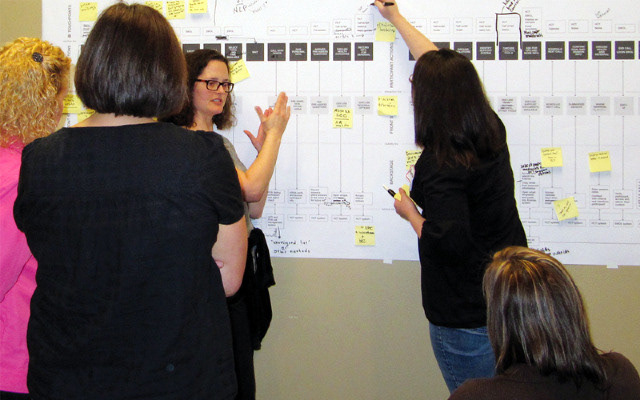
When a company decides to rebuild the systems, processes and platforms that their current organization runs on, it can be a paralyzing task.
Can service design help?
We believe it can. Service Design, an area of practice within the design field, is responding to the increasing importance of services within our economy. Designing for services requires a holistic approach capable of resolving the conflicts between the needs of the service providers to innovate and the improvement of the user experience throughout time and through many different touchpoints.
Steven Dean,G51 Studio, and I led a team of more than twenty individuals from a health coaching and disease management company through an 8-week process that involved workshops, blueprinting, journey mapping, persona development, wireframing, and more with the intent of mapping what the future could look like for this organization. G51 Studio’s goal throughout the project and workshops was to provide the team members with the necessary knowledge and skills to develop service blueprints for their organization's products and services.
The workshop participants developed a service blueprint diagram for a pre-determined part of their service ecosystem to (a) articulate the overall customer journey, interactions and service system and (b) highlight opportunities for the product team to improve and bring new features to the customer experience.
Below are excerpts from a booklet we created that highlights the output of the project.
Below are excerpts from a booklet we created that highlights the output of the project.
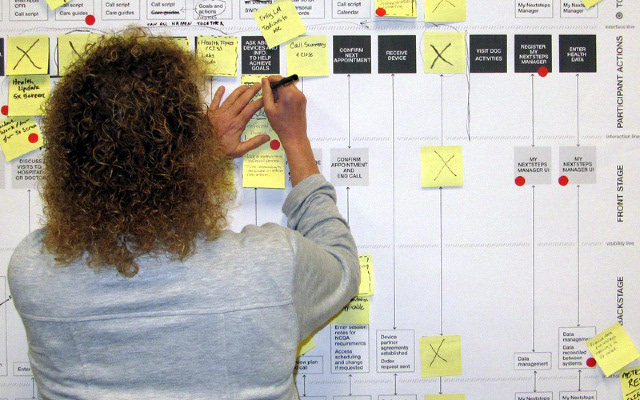
Service blueprints
Throughout the workshops, teams were asked to analyze blueprints of the current state their various systems. The blueprints were based on the existing materials and initial discovery work done by our team.
The main goal of this exercise was to focus on the customer's journey throughout the current service. Teams identified customer actions, service provider actions, the touchpoints (physical evidences that give tangibility to the service) and the processes used to support the service in general.
The objective of this exercise was to understand and map the current state of the service ecosystem, shifting the point of focus for the design process to the organization's customers.
In this activity, teams learned:
Throughout the workshops, teams were asked to analyze blueprints of the current state their various systems. The blueprints were based on the existing materials and initial discovery work done by our team.
The main goal of this exercise was to focus on the customer's journey throughout the current service. Teams identified customer actions, service provider actions, the touchpoints (physical evidences that give tangibility to the service) and the processes used to support the service in general.
The objective of this exercise was to understand and map the current state of the service ecosystem, shifting the point of focus for the design process to the organization's customers.
In this activity, teams learned:
— To separate the service from the two main perspectives (customers and providers)
— To identify the different lines that divide and articulate the service (interface, interaction, visibility and internal interaction)
—To identify the touchpoints and the internal processes used to support the service.
The blueprint activity also served to stimulate the generation of early ideas to inform the mapping of the future state, as teams identified ‘breakdowns’ and ‘magic moments’ throughout the journey.
— To identify the different lines that divide and articulate the service (interface, interaction, visibility and internal interaction)
—To identify the touchpoints and the internal processes used to support the service.
The blueprint activity also served to stimulate the generation of early ideas to inform the mapping of the future state, as teams identified ‘breakdowns’ and ‘magic moments’ throughout the journey.
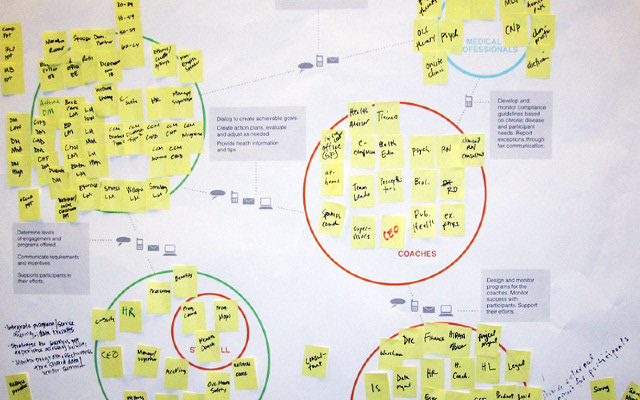
Who are the stakeholders?
The teams were asked to list all the various stakeholders in the service ecosystem. The purpose of the activity was to identify all the stakeholders to consider when designing and mapping the service. Teams were encouraged to reference this map as part of their review of the current blueprint and development of the future state map.
The teams were asked to list all the various stakeholders in the service ecosystem. The purpose of the activity was to identify all the stakeholders to consider when designing and mapping the service. Teams were encouraged to reference this map as part of their review of the current blueprint and development of the future state map.
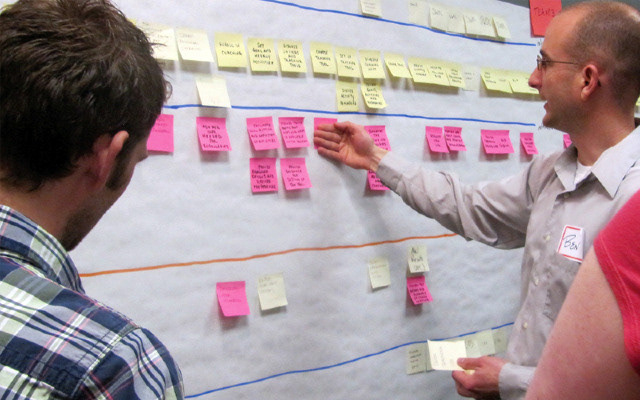
What does the future look like?
We reviewed work and questions that occurred between the workshops in addition to reviewing the current state blueprints. This was followed with an overview lecture. We reviewed the stages of a design lifecycle, sequencing, feedback loops and behavior change. We discussed what we would be designing when looking at the future state. We discussed the meaning of the components of desirability in a service offering including usability, pleasurability and utility.
— What is complexity in a system and how can it be reduced?
— What are coordinated actions and “conversation” models?
— What are the phases of a service; its lifecycle?
— Why is language important for the future state?
— How can first and second-order feedback loops help us improve the future?
Sequencing services
We explained what sequencing is at it relates to behaviors/actions and service journeys. Teams practiced sequencing, by mapping the steps taken to donate to the Red Cross. Teams quickly realized how difficult it is to think about every step needed and to state it clearly using verbs and nouns. The purpose was to practice sequencing with a familiar process, so that teams could learn the skills needed to work on a future state blueprint.
We reviewed work and questions that occurred between the workshops in addition to reviewing the current state blueprints. This was followed with an overview lecture. We reviewed the stages of a design lifecycle, sequencing, feedback loops and behavior change. We discussed what we would be designing when looking at the future state. We discussed the meaning of the components of desirability in a service offering including usability, pleasurability and utility.
— What is complexity in a system and how can it be reduced?
— What are coordinated actions and “conversation” models?
— What are the phases of a service; its lifecycle?
— Why is language important for the future state?
— How can first and second-order feedback loops help us improve the future?
Sequencing services
We explained what sequencing is at it relates to behaviors/actions and service journeys. Teams practiced sequencing, by mapping the steps taken to donate to the Red Cross. Teams quickly realized how difficult it is to think about every step needed and to state it clearly using verbs and nouns. The purpose was to practice sequencing with a familiar process, so that teams could learn the skills needed to work on a future state blueprint.
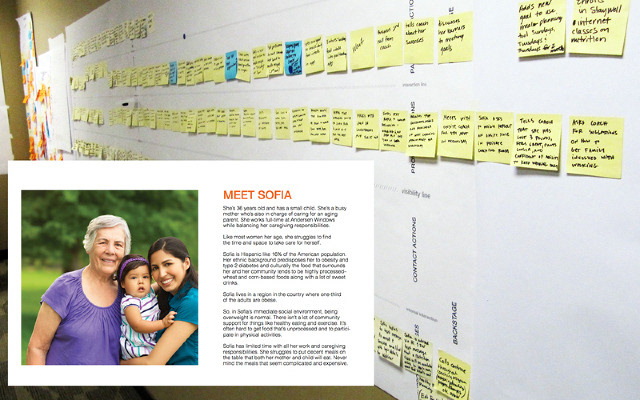
Sequencing services
We explained what sequencing is at it relates to behaviors/actions and service journeys. Teams practiced sequencing, by mapping the steps taken to donate to the Red Cross. Teams quickly realized how difficult it is to think about every step needed and to state it clearly using verbs and nouns. The purpose was to practice sequencing with a familiar process, so that teams could learn the skills needed to work on a future state blueprint.
We explained what sequencing is at it relates to behaviors/actions and service journeys. Teams practiced sequencing, by mapping the steps taken to donate to the Red Cross. Teams quickly realized how difficult it is to think about every step needed and to state it clearly using verbs and nouns. The purpose was to practice sequencing with a familiar process, so that teams could learn the skills needed to work on a future state blueprint.
Personas and and the future
Each team was given a different persona to help them envision the future and capture various services their organization provides. The personas covered a range of individuals from those with diseases including high blood pressure, COPD and diabetes to those seeking lifestyle services.
The teams were encouraged to borrow post-its and concepts from the previous activities along with using role-playing to help them imagine what this future service might look like for their personas. Teams were reminded to think about the principles of behavior change previously discussed and the magic moments identified in the current state blueprints. Each team provided blueprints of their work. All of the work was recorded by our team during design synthesis and in preparation for the final workshop.
We created a new version to serve as a starting point for the future state mapping the work from the teams and the agreed upon behavior change model for the service. Additionally, we created models as part of our design synthesis process to further explain concepts. These were used to discuss the direction of the future state blueprint and the service ecosystem.
Each team was given a different persona to help them envision the future and capture various services their organization provides. The personas covered a range of individuals from those with diseases including high blood pressure, COPD and diabetes to those seeking lifestyle services.
The teams were encouraged to borrow post-its and concepts from the previous activities along with using role-playing to help them imagine what this future service might look like for their personas. Teams were reminded to think about the principles of behavior change previously discussed and the magic moments identified in the current state blueprints. Each team provided blueprints of their work. All of the work was recorded by our team during design synthesis and in preparation for the final workshop.
We created a new version to serve as a starting point for the future state mapping the work from the teams and the agreed upon behavior change model for the service. Additionally, we created models as part of our design synthesis process to further explain concepts. These were used to discuss the direction of the future state blueprint and the service ecosystem.
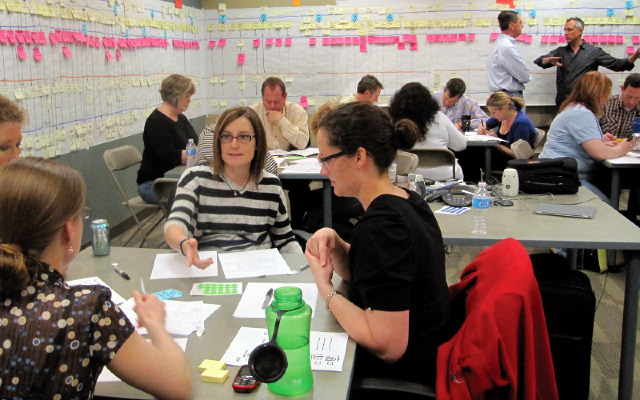
Mapping the future state
Teams began by reviewing and revising the participant and provider actions we had mapped. The purpose was to begin to map the important interactions for the future state before working on the touchpoints and support processes needed. The activity provided an opportunity to review the roles mapped within service blueprints in addition to discussing the services that were important to include in the future state.
Teams adjusted the map and went on to add both contact actions and support systems for the mapped interactions. The process encouraged discussions and opportunities to imagine new possibilities for the future. There were many discussions about removing complexity and simplifying services and support processes for the future state. Teams referenced the current state to identify opportunities and prevent the repitition of fail points in the current system.
Teams began by reviewing and revising the participant and provider actions we had mapped. The purpose was to begin to map the important interactions for the future state before working on the touchpoints and support processes needed. The activity provided an opportunity to review the roles mapped within service blueprints in addition to discussing the services that were important to include in the future state.
Teams adjusted the map and went on to add both contact actions and support systems for the mapped interactions. The process encouraged discussions and opportunities to imagine new possibilities for the future. There were many discussions about removing complexity and simplifying services and support processes for the future state. Teams referenced the current state to identify opportunities and prevent the repitition of fail points in the current system.


